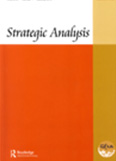Border Management and India’s North East
The management of India's international border along its North Eastern States has remained a crucial and complex issue. In an age of increasing interdependence, threats from unconventional sources pose a greater challenge to the country's security. An unmanaged border accentuates such threats by providing easy points of ingress and egress. Travel along India's borders with Bangladesh, Myanmar and Bhutan highlights the porous nature of these borders, which pass through difficult terrain of forest, rivers and mountains and make the task of guarding all the more challenging.
- Shanthie Mariet D’Souza
- July 18, 2006










